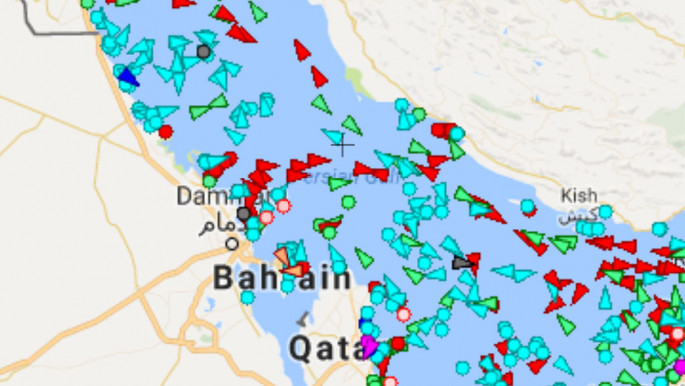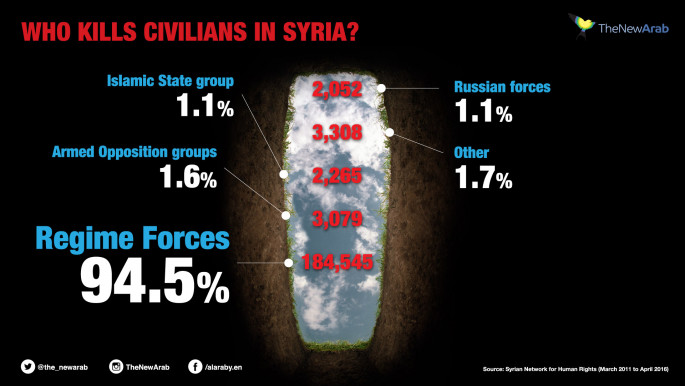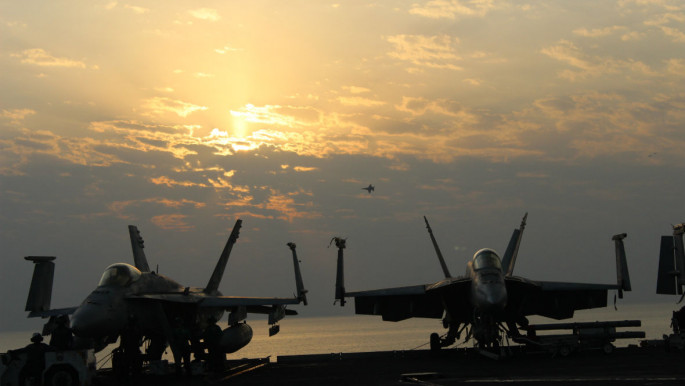Life aboard the aircraft carrier bombing Syria and Iraq
The role of the USS Dwight D Eisenhower, one of the world's largest aircraft carriers, is to project US military power over a 1,000-mile radius.
Here in the middle of the Gulf, a half-hour cargo plane flight from Bahrain, it is fulfilling two principal operations - supporting the fight against the Islamic State group in Iraq and Syria, bombing what military officials believe to be IS camps and associated vehicles in pre-planned strikes, or patrolling an area in support of ground troops - all while projecting that aura of military might to keep the oil flowing in this key resource-rich region.
Keeping shipping lanes open is good for the global economy in a world unable or unwilling to end its dependency on the fossil fuels within these tankers, say economists.
"We are deeply committed to the security of our friends and partners here," a senior US Navy official told The New Arab.
And even as the Eisenhower hands over maritime operations in Operation Inherent Resolve to Britain's flagship, HMS Ocean (one-fifth the size of the Eisenhower), the US Navy and Air Force will continue to continue to conduct surveys, patrols and strikes in the region.
 |
|
| The Gulf is a very busy area for oil tankers and other shipping [Screenshot: MarineTraffic] |
Extensive training with other militaries, such as Britain's Royal Navy, leads to "a seamless plug-and-play of allies", the Navy official claimed.
But such cooperation has its limits, especially in the skies above Syria.
"We don't co-ordinate with the Russians," the official made very clear.
"If I'm walking down the street, and I see you walking down the street, and I cross the street so I don't hit you walking down the street… well, that's not 'co-ordination'."
In the past five months, the Eisenhower has launched more than 1,600 airstrikes in Syria and Iraq - some 20 percent of the coalition's total in that time. The vast ship, along with its accompanying destroyers, cruisers and other supply vessels that make up this strike group, left its home port of Norfolk, Virginia, in June, and carried out operations, including 116 airstrikes, from the Eastern Mediterranean on its way here.
Aerial firepower from the US-led coalition has been credited with turning the tide in the fight against IS. The militant group has lost thousands of square miles of territory it once controlled with its perverse violence. But civilians have also been killed. Ordinary, everyday people trying to get on with their lives, as if they didn't already have enough to cope with, have died fiery deaths as a direct result of these airstrikes.
The bombing of Syrian troops by US-led coalition aircraft was also blamed in the collapse of the fragile ceasefire in Aleppo.
Estimates of the civilian death toll vary widely. The coalition has acknowledged 19 civilian deaths from around 8,000 raids on Syria, using the sanitised military term "collateral damage". Monitoring groups such as Airwars put the toll at close to 900. In October, Amnesty Internationalsaid at least 300 Syrian civilians had died in US-led airstrikes.
In context, IS has butchered more than 3,000 people, the Russian air force has been blamed for more than 3,400 civilian deaths, and it is thought President Assad's troops have killed at least 150,000 of their fellow countrymen and women.
 |
|
| [Click to enlarge] |
Julius Bratton is an F-18 jet fighter pilot with the callsign "Whiskers".
Yesterday, he flew a 90-minute mission (most likely in a perimeter patrol of the carrier's strike group, though exact details remain classified) which required more than seven hours of planning and preparation.
"Having years of experience and training helps," he told The New Arab.
"Having a JTAC [a 'spotter', usually a former pilot, embedded with ground troops] with eyes on the ground or a UAV [drone] helps. Targeteers do a collateral damage assessment, and then I'll do a re-assessment from the cockpit before the strike.
"That's where the training and experience comes in."
 |
| Lieutenant Julius 'Whiskers' Bratton says hours of planning goes into each mission [James Brownsell] |
Like others on board, he takes the moral high ground when asked about his motivations; when questioned on the feelings of solidarity between pilots and the desire for vengeance when one of their own is shot down, captured, tortured, and killed - as happened with Jordanian F-16 pilot Muath al-Kasasbeh in January 2015.
"I'd never use hatred [when attacking], because I feel that's what ISIS uses to motivate themselves."
There are some 5,300 crew on board this floating city. In the past 175 days the Eisenhower has been at sea, it has spent 15 days in port. Most sailors working 12-hour shifts will have had around ten days' leave during the past six months.
Lengthy deployments at sea, though obviously an inherent part of the job of a sailor, are tough not just for the crew, but for those waiting at home. And though food rations onboard an aircraft carrier are better than many military meals, there is still celebration when the ship's stores are replenished and fresh food makes it to the galley.
More than 400 turkeys were brought on board ahead of the Thanksgiving holiday - though the day was marked by a meal shared with comrades rather than a day off, and, for most on board it was the second year in a row to be away from feasting family and friends due to the rotation of deployments - but this latest replenishment gave extra cause for cheer: Christmas presents had arrived early.
 |
| Sailors stand ready in the hangar bay of the USS Eisenhower as a helicopter transfers supplies and gifts from the USS Arctic [James Brownsell] |
Usually, the US military advises sailors' loved ones that it will take six weeks for gift packages to reach crew members on active service, but given the US Navy's long relationship with the autocratic Kingdom of Bahrain - there has been a navy base in Manama for at least 45 years - the postal service is more reliable here than it is in many of the thousands of places across the planet to which the Pentagon sends its troops.
There is a bonus present. The ship will soon be headed home. Passing back through the Suez canal and the Mediterranean, it is unlikely to make it across the Atlantic in time for Christmas. Maybe, if duties permit, it may make it back to Virginia for new year, the ship's captain, Captain Paul Spedero Jr, told The New Arab.
 |
|
| In pictures: Click here for more photos from the USS Eisenhower [James Brownsell] |
That timeline largely depends on the Russians.
Moscow's aircraft carrier, the Admiral Kuznetsov, is sailing in the Eastern Mediterranean, also bombing what it claims to be "terrorist" targets in Syria.
The Kremlin's definition of "terrorist" is notably aligned with Assad's, which appears to include anyone expressing any form of opposition to Damascus, either armed or otherwise - or people who live in the same towns as those who do.
But the Eisenhower wasn't sent here to counter Russia's naval power.
"There's no link between where we're operating and where the Russians are," Commodore Scott Switzer told The New Arab on the Admiral's bridge, high above the carrier's flight deck.
"Our operations were planned long before the Russian deployment," said Switzer, commander of the carrier group's destroyer squadron.
| Read more: Worship on a warship - how chaplains assist spiritual development during warfare |
When the Eisenhower came through the Mediterranean on its way to the Gulf some months ago, the carrier group was tailed by a Russian ship, which stayed around seven miles to the rear of the strike group. No entanglements ensued.
"We were in international waters, so they had every right to be there, just as we did," said Switzer.
The reliability of the Russian navy's sole aircraft carrier has been called into question in recent media reports. Last week, a crucial deck cable snapped as an Su-33 jet fighter attempted to land with a tail-hook. Its pilot safely ejected before the multi-million-dollar plane crashed into the sea.
"I'm not going to say the Russian navy isn't a threat," Switzer told The New Arab.
The Eisenhower is gargantuan. Its flight deck covers an area larger than four football pitches. It is powered by two nuclear reactors. Its kitchens serve up 15,000 meals every day. Each of its two anchors, including chains, weigh 735,000lbs. Its captain, himself a career naval aviator having flown both F-14s and F-18s, was both a graduate of and instructor at the prestigious Top Gun flight school in Nevada - and he continues to fly missions in a 1,200mph-capable F-18 Superhornet - one of more than 60 strike aircraft on board.
"This aircraft carrier is the most capable aviation platform - it is second to none in the world," said Switzer. "But that doesn't mean there are no threats."
 |
|
| The story behind the story: US Navy dresses to impress Arab media, but what comes next? [James Brownsell] |
The bombing of the USS Cole in the year 2000 by suicide bombers on an explosives-filled boat led to a total overhaul of protection of ships both at sea and in port. While the Russian navy is active in the Mediterranean, small Iranian submarines patrol the strait of Oman at the mouth of the Gulf.
"We have near daily interaction with small Iranian ships," said Switzer. "Again, these are international waters. Our dealings with them are very professional and routine, based on communication… We track everything out here."
Dozens of crew in bright jumpsuits - each colour denoting a crew member's role - control operations on the flight deck. Using a steam-powered catapult which flings aircraft off a 500ft stretch of deck from 0-170mph in less than two seconds, they can launch two jet fighters in just 36 seconds. It takes less than an hour to reach IS-controlled territory in Iraq and Syria.
It is not uncommon for the onboard air traffic controllers to send out 70 aircraft on missions each day.
"And on a good day, all 70 come back," one senior officer in the flight tower remarked.
The New Arab watched as wave upon wave of jet fighters, bombers, reconnaissance planes, strike helicopters and refuelling aircraft were dispatched from the flight deck into patrol and strike operations. Hours later they all returned safely under the veil of darkness, though not all landed with a full complement of missiles.
While these pilots, their aircrew and the vast infrastructure of sailors supporting them will live to fight another day, the same cannot be said of those in their crosshairs.
Follow James Brownsell on Twitter: @JamesBrownsell
Editor's note: Since James was on board, the Eisenhower has moved to the eastern Mediterranean, where it continues to conduct operations





 Follow the Middle East's top stories in English at The New Arab on Google News
Follow the Middle East's top stories in English at The New Arab on Google News


